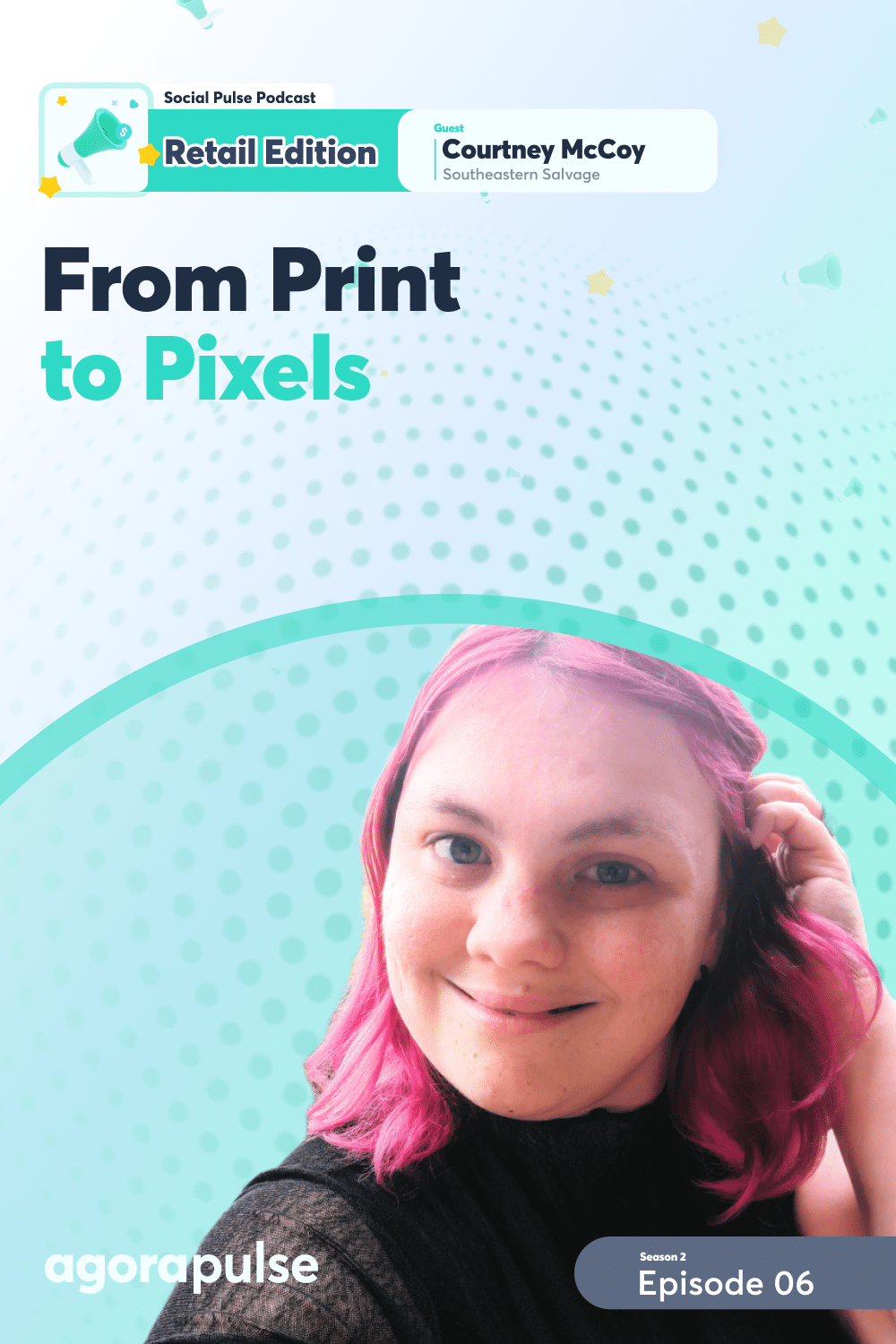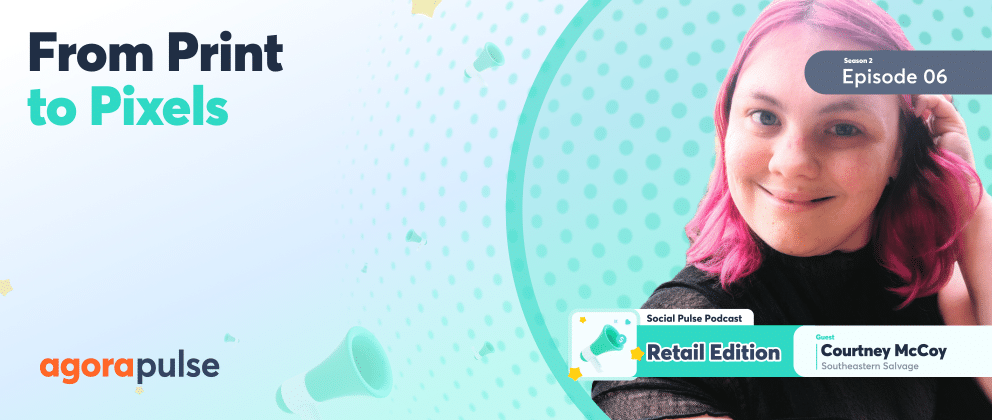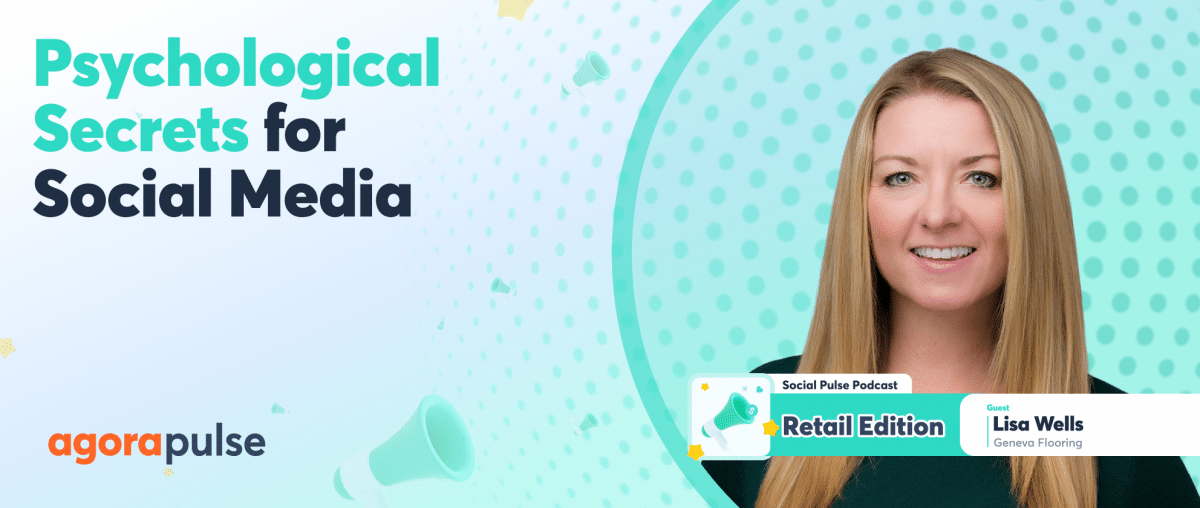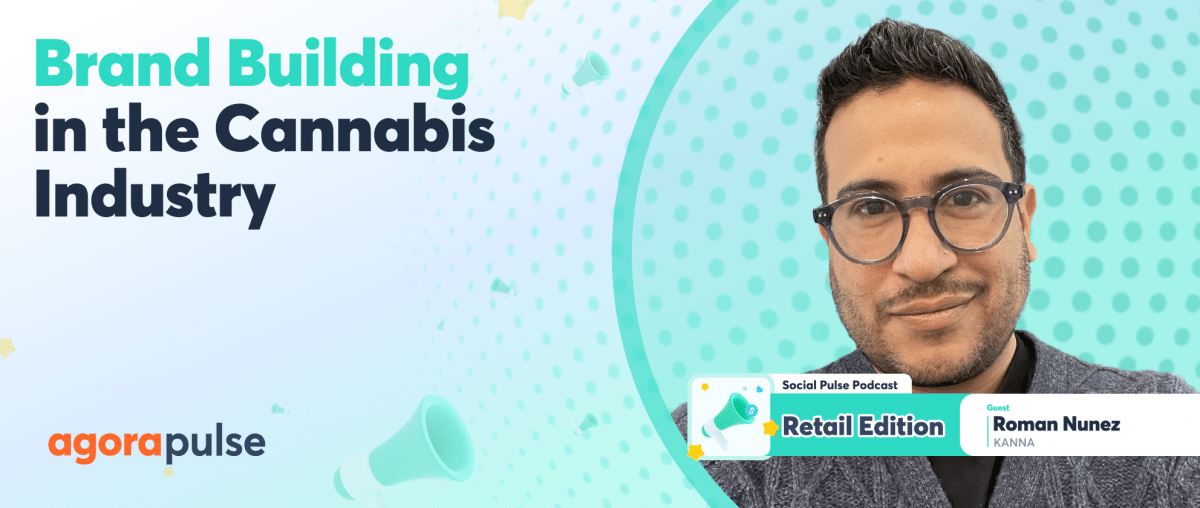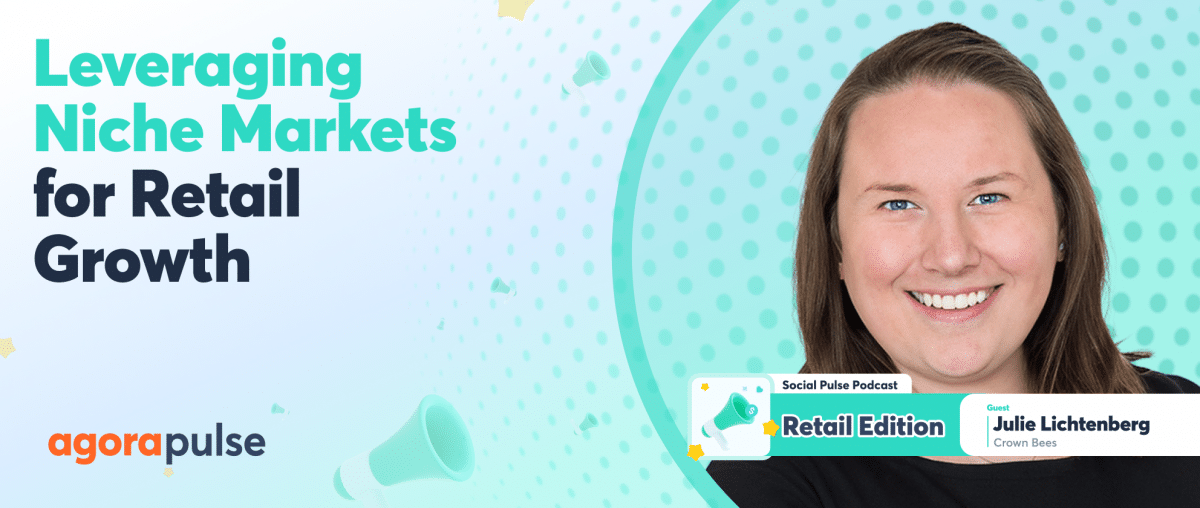Are you part of a retail business struggling to move away from traditional newspaper and magazine advertisements, feeling overwhelmed by the shift, digital marketing, and social media?
Many brick-and-mortar stores face significant resistance to change. They rely on methods they’ve known for years, leaving them hesitant to embrace new platforms and strategies. And this hesitation can leave your business lagging behind, missing out on the vast potential and engagement that social media offers, how do you break through those barriers and convince your team to embrace this change?
Social Pulse Podcast: Retail Edition guest Courtney McCoy has successfully navigated this transition and turning resistance.
As a seasoned social media manager, Courtney took a brick-and-mortar store from relying solely on print ads to achieving a 700 percent increase in organic reach through social media. Her expertise has brought life and engagement to traditional retail, making her a perfect guy for anyone facing this challenge. The following is a recap of the episode, hosted by Agorapulse’s chief storyteller, Mike Allton.
The Transition From Store to Digital: Courtney’s Story
Share about your role and some of those initial challenges that you faced when trying to transition that traditional store to digital marketing.
Courtney McCoy: I was considered the social media coordinator of my job. I work for a large home improvement/furniture company, and we have 11 stores in the location and the Southeastern region. My job was to make sure that every store had content coming out regularly. My biggest challenge was getting them to see the importance of having consistent content and having their customers know what’s up.
How did you address (and what were some of) the biggest hurdles that you encountered when you were working with that company’s leadership and their staff when trying to introduce social media marketing?
Courtney McCoy: We had a marketing director who did most of the magazine ads. They did newspaper ads. They were doing a lot of the old-style sort of marketing.
So when I entered the picture, they had heard of social media marketing. They wanted a social media coordinator, but they didn’t have any idea where to start. What I did was I came in, and they had tried a few different social media coordinators, but nothing stuck.
My goal was to build something from the ground up, building a content strategy and honing in on consistent posting every single day. They’d already tried this a couple of times.
The difference for me was convincing them that it was worth the money, worth the investment, and working on organic content versus the paid social media ads.
They had some success with the paid social ads during the pandemic, but they weren’t focused on the organic day-to-day posting—which for a lot of people, that’s where their bread and butter is, the day-to-day foot traffic that stores rely on people coming in the door to see their new products.
When they were just doing these little blasts, like a week, they were doing three-day weekend blasts, 50 a day on Facebook and, sure, they’d get some sales, but they weren’t doing a whole lot with the wide variety of products that they were offering.
Nobody knew what we were offering.
Mike Allton: You were showing them a lot of educational content that we mentioned at the outset—a 700% increase.
Courtney McCoy: 700%. I was shocked by the number myself because we had gotten a little bit of here and there on one of the old social media posts—which you post here and there sporadically—but what helped was the consistency of posting every day around the same time and utilizing the different platforms.
We were just doing Facebook. Now we’re doing Instagram. Now we’re doing Twitter. Now we’re doing Pinterest, just leveraging all of the different platforms to just drive that traffic and get more eyes on our products.
What were some of the other strategies that you use that you think might have helped you get to that level of organic reach?
Courtney McCoy: We worked with our customer base.
A lot of customers would come to our stores to do home renovation products or projects. They would come and buy cabinets, they’d buy butcher blocks, they’d buy flooring, and realistically, after they left, we never knew what happened.
So by utilizing these channels with Facebook and other platforms, we were able to see what people were doing with our projects or doing with their projects with our materials.
And then what ended up doing was sharing those with the audience, like, “Look what you could do. Look what you could do with our projects. See what Mary in Charlotte, North Carolina, has done with this butcher block.”
As I kept posting, we kept getting more and more engagement, and more and more customer photos started flooding in. The content was making itself in a sense.
Were there other types of content that you tried or how did you decide or find out that this particular approach was going to be the best one?
Courtney McCoy: We tried a lot of different methods. We tried a lot of traditional—what they wanted was sales ads, right? “Here’s the picture of the product. Here’s the price. Come buy it.”
And that kind of marketing just doesn’t hardly work anymore. Everybody does that. Everywhere you see a big billboard. “Here’s a couch, and here’s the prize.”
What I wanted to do was make it more of a back-and-forth between us and the customer.
So we did try some of those “here’s the thing, here’s the price.” And for some products that did work well, but for most products, such as flooring and hardwood doors, things of that nature, it just wasn’t selling because they couldn’t see the benefit. They couldn’t see it in their own home.
Of the other platforms that you were engaging on, was there one in particular that you saw the most success on?
Courtney McCoy: Facebook was the one we had the most success with.
And that was because what we ended up doing for Facebook was we separated it by store.
Each of our locations has its own Facebook page and we were posting things relevant to that store. We have 11 locations.
Mike Allton: That is a lot of Facebook pages!
Vanity Metrics vs Reach
Mike Allton: Obviously, reach is fantastic, and I’m sure some of the other metrics that you were seeing were really great as well, but …
How do you balance the need for professional authentic content while avoiding some of the pitfalls of focusing too much on what some might consider vanity metrics?
Courtney McCoy: Vanity metrics. That was the biggest thing.
They wanted to know how much of this we were getting, how much of that we were getting, and there was no direct way to track foot traffic in the store versus what we were getting on Facebook—just the number of comments versus foot traffic.
There was no correlation at all.
What I had to get them away from was, yes, people are posting, but that doesn’t mean they’re coming into the store. But people who are seeing it may be coming into the store. They’re just not posting about it.
It was really important to not look at the engagement, per se, but we wanted to see who had eyes on our posts. We wanted to know who we were actually reaching.
Reach and impressions were the two main things I measured. I wanted to get as many eyes on it as possible. And, hopefully, some of those eyes ended up looking in the actual stores themselves.
Mike Allton: So you got buy-in from management to embrace brand awareness as the metric and just assume that as you’re getting enough brand awareness, then that’s going to translate into sales into the stores. At some point, when those buyers are ready—because we all know, just because I see a couch on Facebook, it doesn’t mean I’m ready to buy a couch on Facebook, even if it’s someone showing off just how amazingly well that they put it in their home.
And there’s a wonderful story about that. The best post in the world is not going to make me want to buy that piece of furniture unless I’m in a position to do it.
But six months later, I might remember, “Oh, you know what? We need a couch now and I know where I can get a fantastic piece of furniture.” I love that approach.
[Check out past episodes of the Social Pulse: Retail Edition on the Agorapulse blog.]
Can you talk about the importance of community management and how you’ve built such an engaged online community for your stores?
Courtney McCoy: A lot of it was posting those customer stories.
By posting those customer stories, it started out with just reviews. We would post good reviews that we got.
“Oh, Jeff helped me down at the Columbia location and he was really nice.” And so what I ended up doing was reaching out to Columbia. “Hey, Columbia, do you have a picture of Jeff? Oh, fantastic. I’m going to pair this picture of Jeff with this review.”
And that helped bridge the gap between the store and the customer.
And that was my goal as a social media coordinator: to bridge that gap.
As I started doing that and more people started posting their projects, more and more people started coming forward.
Like, “Hey, I bought that at Southeastern Salvage,” or, “Hey, I was at Chattanooga, and so and so helped me.” So by doing that, it just opened the door for more and more like an avalanche. They just kept coming and coming and coming.
Now we’re at a position where every week I have three or four new stories in my inbox ready for me to share
Mike Allton: What a treasure trove. I know a lot of folks listening are going to be jealous that amount of of UGC and those great reviews and pairing those with the specific people at the stores. That’s just brilliant.
What a terrific way to humanize the brand because we buy from people and so we want to be able to know who we’re talking to.
Paid Social (and Measuring Effectiveness)
Let’s talk about paid social for a second. Shifting gears a little bit.
What were some of the strategies that you used to run paid social media, some ad campaigns, and traffic campaigns, and how did you measure their effectiveness?
Courtney McCoy: That is a great question because as I said the previous social media coordinator had tremendous success with these three-day paid ads, but I wasn’t having the same amount of success.
The market has changed, and after the pandemic, most people are shying away from buying a lot of high cost products.
What we ended up doing was doing a longer-term campaign where we would run 10-day campaigns featuring two weekends. So I’d start them on Thursday, and I’d run them until the following Sunday for 10 days to maximize those weekends because that’s where we had most of our visitors—people scrolling on the weekends, looking for new project ideas, looking for new things to buy because they were home.
During the week, we didn’t do so much, but having it consistently running those 10 days, Facebook appreciated it, and it boosted our numbers versus just a little three days here and there.
Mike Allton: That makes a lot of sense. That’s the kind of advice I’ve heard often from paid ads experts: if you only run an ad for a couple of days, you’re not giving that algorithm enough time to learn about your audience and how they’re resonating or not with the ad. Terrific approach.
I’m wondering if you could share an example of a success story, one of these campaigns, whether they were paid or organic that you led as part of this transition to digital marketing.
Courtney McCoy: One of my favorite stories was we got this huge shipment of dog treats. I’m talking big bones, buffalo ears, you name it, all sorts of different kinds of dog treats.
What I ended up doing was launching a campaign that says, “Hey, if you buy our dog a treat and you post a picture with your dog enjoying them with #SESdogs, we will feature your dog.”
And that got a lot of people talking. We had a huge influx of people posting their dogs enjoying these big raw hide bones. These little dogs with their little treats. Just dogs and dogs and dogs, and people love dogs. People love animals. And that was just building a lot of engagement.
We featured several dozen dogs throughout that month.
With the dog treats, we were able to partner with local adoption agencies and shelters, and we were offering adopt-a-thons at some of our stores.
We were giving back to the community in that way as well.
Mike Allton: Oh, I love that story. That’s fantastic. It’s funny. I was interviewing someone else for our B2B podcast, Jay Baer, and he was telling the story of one of his clients who was a farm seed company, and they started featuring farm dogs every Friday on their Facebook page. To your point, people love dogs. And so that became their most successful thing because farmers and their dogs, they love it.
That’s the real takeaway from this interview, folks. You got to work dogs into your marketing strategy, one way or another!
But in all seriousness, I love this idea because what you’ve done is encourage customers to come into the store and pick up a relatively inexpensive item. Now that they’re there, [they] can look around and see what else that you’ve got. Love that draw for foot traffic.
Top Three Takeaways
Share your top three lessons that you’ve learned so far from your experience that might benefit a lot of the other retailers who are listening.
Tons of social media managers facing these kinds of struggles. Maybe they’ve been with a brick and mortar for a long time, and they’re still not getting that buy-in from management.
What would your advice be?
Courtney McCoy: Number one: Don’t back down. If you are a small social media manager in a large company, you’re probably getting all kinds of pushback, all kinds of ideas.
Stick to what you know because you went to school for it, or you did all the training for it. You know what you’re talking about.
Trust your instincts, trust your knowledge, and don’t back down.
The second thing: Stick it out. Like you said with the Facebook ad campaigns, the longer they run, the more time the algorithm has to learn. Give it a few days, and if it’s not showing progress right away, just give it a few days and stick it out. You may be surprised.
On the other hand, I would say also be flexible. Flexible like, “Hey, this isn’t necessarily working. We did give it a few days, but let’s try something else.”
Being able to take something and flop it or present it a different way will help you maintain consistency and maintain a nice even flow of leads and customers
Don’t forget to find the Social Pulse Podcast: Retail Edition on Apple and drop us a review. We’d love to know what you think until next time
